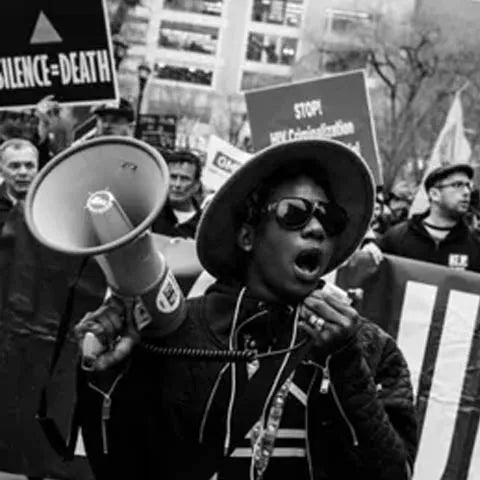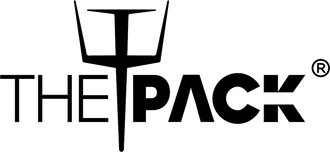
MARCH 12th: The ACT UP Movement
The date March 12th marks a pivotal moment in the history of LGBTQ activism and the fight against HIV/AIDS. On this day in 1987, roughly 300 people gathered at the Lesbian and Gay Community Services Center in New York City to form a new grassroots organization known by the acronym ACT UP, the AIDS Coalition to Unleash Power emerged in 1987, challenging government inaction and public apathy surrounding the AIDS crisis.

This meeting, called by prominent playwright and author Larry Kramer, was a flashpoint - the beginning of a radical protest movement that would shock complacent government officials and homophobic elements of society out of deadly inaction and into taking real steps to address the exploding AIDS crisis.
The Genesis of a Movement

(Image of Larry Kramer)
In 1981, a rare cancer called Kaposi’s Sarcoma and a strange form of pneumonia began appearing more frequently among gay men in Los Angeles and New York. By the following year, the Centers for Disease Control (CDC) had coined the term Acquired Immunodeficiency Syndrome or AIDS to describe the puzzling new disease that attacked victims’ immune systems.
As AIDS cases multiplied, infecting not just gay men but also heterosexual men and women, intravenous drug users, and blood transfusion recipients, the federal government’s response was painfully slow and inadequate. President Ronald Reagan did not publicly speak about AIDS until 1985, when his friend and fellow actor Rock Hudson became one of many public figures to die from the disease.
Misinformation, homophobia, and moralizing hampered public understanding and compassion towards AIDS victims. Many Americans supported discriminatory measures like workplace firings and housing evictions of those stricken with the illness which was still poorly understood.
While groups like Gay Men’s Health Crisis provided social services, there was no loud, disruptive voice demanding government action and accountability from powerful institutions like pharmaceutical companies, hospitals, insurance providers, and public officials. The ACT UP meeting on March 12th 1987 changed that by founding an advocacy group centered on the strategy of direct action.
That First Historic Meeting

The roots of ACT UP can be traced back to a speech Larry Kramer delivered in March 1987 at the Lesbian and Gay Community Services Center. Kramer, a controversial firebrand known for works like “The Normal Heart” and “Faggots” which frankly depicted gay male sexuality and relationships, had formerly served on the board of GMHC but split from the group in 1983 due to creative differences.
In his March 1987 speech, Kramer issued a call to action over GMHC’s polite, accommodationist approach towards authorities in addressing the AIDS crisis. To Kramer, this style was not working while thousands needlessly suffered and died. He asked the audience “Do we want to start a new organization devoted to political action?” The resounding answer was yes.
Within two days of the speech, about 300 people returned to the Center to put Kramer’s call into action by creating a new group unaffiliated with GMHC. That group was ACT UP, and its members quickly agreed on core principles that would guide their protest actions going forward:
- Government inaction was killing people with AIDS, and this genocide must stop
- People with AIDS and their advocates must have a seat at the table where decisions about research, healthcare, funding, and education get made
- ACT UP would coordinate grassroots chapter groups focused on planning highly visible demonstrations, zap actions, and protests to fight HIV/AIDS discrimination
A Movement Gains Momentum

Equipped with righteous anger and its confrontational name deliberately invoking images of protest movements past, ACT UP soon began making its voice heard loud and clear in New York and beyond.
One of ACT UP’s first major protest actions took place on March 24, 1987 on Wall Street. About 250 activists shouted slogans like “Health care is a right!” and held bold signs to draw attention to pharmaceutical company Burroughs Wellcome’s exorbitant $10,000 a year price tag for AZT - the first and only FDA approved anti-AIDS medication on the market.
Seventeen members were arrested for civil disobedience. A year later on March 24th 1988, ACT UP returned to Wall Street with increased participation and media coverage, establishing an annual tradition of demonstrations there. Chapters sprouted up across America in cities like Chicago, Boston, Philadelphia, and San Francisco.
As the AIDS epidemic exploded in the late 1980s, ACT UP kept the pressure on with high-profile zaps and actions. In October 1988, 1,000 protesters descended on the Federal Drug Administration headquarters for a daylong siege and “die-in” to demand accelerated approval procedures for emerging AIDS treatments. This demonstration was considered a great success as the FDA did in fact implement those very reforms over the following year.
Other major early ACT UP demonstrations targeted the New York Stock Exchange over drug pricing in September 1989, the Centers for Disease Control over its narrow definition of AIDS in 1990, and culminating in May of 1990 with over 1,000 activists taking part in a massive national protest dubbing “Storm the NIH” a government health agencies in Maryland.
From “Stop the Church” to Ashes on the White House Lawn

Beyond its focus on speedier access to AIDS drugs and promoting public awareness, ACT UP took on other causes and institutions. The Catholic Church became a target due to policies discriminating against women and homosexuals. ACT UP organized high-profile demonstrations against New York’s St. Patrick’s Cathedral, with the first “Stop the Church” protest in December 1989 seeing over 100 activists arrested for interrupting Mass.
As the organization matured, ACT UP began staging intentionally provocative and morbid media spectacles to shine a spotlight on continued government negligence, such as dumping ashes of AIDS victims onto the White House lawn in October 1992. That election year also saw members parade a coffin to the Bush White House, using pointed political theater to draw attention to their increasingly radical demands.
Ongoing Legacy and Impact

Internally, ACT UP struggled with factionalism over tactical and philosophical direction. By the mid 1990s, the AIDS Clinical Trials Group spun off into its own entity known as Treatment Action Group. But ACT UP continued coordinating demonstrations large and small into the 2000s on the local and national level.
The urgency of the early years may have faded as antiviral cocktails extended lives and HIV transmission rates stabilized. However, chapters in New York and Philadelphia remain active around modern issues like universal healthcare access, drug pricing reform, and LGBTQ discrimination.
Outside of ongoing visible protests though, ACT UP’s bold style of activism and its successful coordination of angry citizens into an influential lobby for change remains an inspiration for organizers in many other spheres.
Indeed, the lasting victory of organizations like ACT UP was proving the power of direct action protest movements to force positive outcomes against long odds. Within five years of its founding on March 12, 1987, ACT UP had pressured health agencies, electoral candidates, drug manufacturers and insurers to radically revise policies to both expedite access to AIDS treatments as well as anti-discrimination measures protecting basic civil rights.
By speaking truth to power loudly enough, ACT UP seized public attention and sympathy. It dragged American society towards finally properly addressing what had been a stigmatized crisis, restoring dignity and agency to marginalized victims in the process. The group’s most meaningful achievement was perhaps demonstrating the collective clout an outraged minority can wield simply by refusing to suffer silently anymore.
In leveraging anger and defiance to penetrate years of deadly mismanagement and prejudice, ACT UP stands as a permanent example of principled grassroots activism scoring real results against initially uncaring establishments. Everything ACT UP accomplished can be traced back to the watershed instant when Larry Kramer issued his fateful call to action, and approximately 300 citizens stepped forward on March 12, 1987 to translate fury and loss into direct action by founding a protest organization unafraid to make demands and get arrested if necessary.
Without the birth of ACT UP on that date, the AIDS catastrophe in America might have claimed hundreds of thousands more lives while regressive public policy metastasized further. March 12th stands as a testament to the power of collective action. On that day, victims and allies shattered the walls of silence, bellowing "Enough!" in unison, and sparking a transformative movement driven by the force of confrontation. Love for friends and family lost to governmental negligence, drug company indifference, and social prejudice fueled ACT UP’s defiant campaign to shake the status quo for the better.
March 12th, 1987 saw ordinary women, men and queer individuals transform into tireless activists under the mantle of ACT UP. Mayor Koch’s New York and President Reagan’s America would never be the same, as this date marked the public debut of fed-up advocates, no longer content to be silent in the face of preventable tragedy. ACT UP would give AIDS a furious, unignorable voice for the next decade and beyond. Shocking, angering, but ultimately successful in moving mountains through the alchemy of rage, the AIDS Coalition to Unleash Power fundamentally changed history by refusing to continue suffering quietly.









